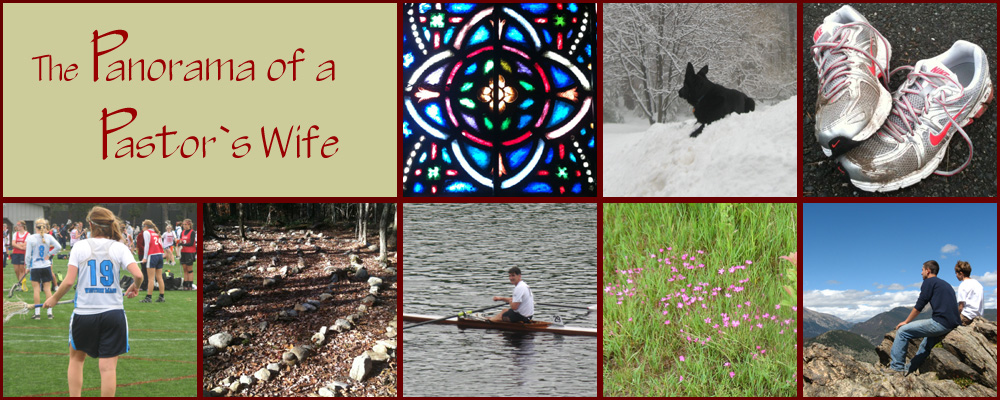Take That Back, Please
Is it ever better to go backwards than forwards? This has been a question swinging up and down, back and forth, hither and yon in my mind over the past week.
If the Consecration made our summer a bit unusual, the fact that I needed to be at school on my birthday did too. Mid-August always finds our family up in northern Vermont, and my husband traditionally plans a lovely party for me there. This week, however, I needed to attend “New Staff Orientation” at the charter school where I work. Even though I started there last spring, I didn’t get the benefit of standing on the shore for a while to be guided into all the expectations and guidelines of this place – I had to dive right into the waves and start swimming. I became the ninth grade teacher for those last few months of the year and somehow survived. This coming year, I move upstairs to work with seniors, teaching one section of regular English and two sections of Senior Project Seminar.
One of the topics that has been presented to us over the past couple of days, relating to curriculum planning, is called “Understanding by Design” or “Backwards Design.” Based on work by Grant Wiggins and Jay McTighe, “UbD” – as it is affectionately called in educator circles, sounding to me like a rock group – is all about trying to define desired outcomes in the classroom first. What is it, exactly, that we want our students to be able to know, to understand, to do at the end of a unit? How will we know if they achieve those goals? If we’re not clear about that right from the beginning, then we risk presenting all of the daily activities and assignments — those things we can’t do without — as just ends in themselves rather than means to a larger end.
Of course this makes plenty of sense: teachers, like any other kind of designers, should be able to envision how they are helping their clients – students – reach specific academic goals. In our case, a variety of standards and frameworks are there to identify what the targets are. We need to choose our content and our “essential questions” carefully, not just pick activities that have traditionally gone over well with students or create a pleasing kind of energy in the classroom. The only kind of thermometer that would be useful for us would be one that shows whether true enlightenment, and the right kind based on what is expected of us in a particular grade level for a particular subject, is on the rise. 
All true, and yet, to be honest, this process is not exactly automatic, either. First I have to get past my discomfort with the words “learnings” and “understandings.” Where did those plural gerunds come from? And then I must accept that it’s not enough to read To Kill A Mockingbird or Othello simply because they are inherently great; the works function as roads that bring students to particular intellectual destinations. I need to able to welcome the question, “What is this going to do for me?” whenever I hear it because it gives me a chance to explain how completing certain tasks will, eventually, get us to the promised land – a place I have already envisioned if not actually visited.
It’s a little bit like plotting out a garden or, on a larger scale, trying to find a new home in a new state: through all the seed planting or the driving and stopping, you have to keep in mind what you want your final achievement to look like. Otherwise you might just stumble around in the dirt, not allowing the right spaces for the right growth. I bet my husband could make a few parallels with congregational life, too: Drawing people into church every Sunday is nice, but you also need to be able to see how it might help to transform them over time and what you are hoping to bring about in their souls.
So this, naturally, brings us back to the Olympics. I know, I know – they’re over and pages and pages have already been written about them. One of my brothers has been known to suffer from “post-Olympic depression.” When else can we be so confident that we will find something worth watching on TV, night after night?
Interesting as it was to learn something about beach volleyball and weightlifting (oh, wait, I didn’t watch that) – it’s always the track and field events that are the most compelling for me. More than any other sport, running is by its very nature completely forward in motion. Could anyone be more aptly named than Usain Bolt? He flies so fast that he actually can afford to look back over his shoulder sometimes, even in a sprint.
But have you heard about that other sport, not yet in the Olympics — backwards running? Advocates say it’s just the thing to balance out a hum-drum regular forwards running life, with a whole set of specific benefits. (Check out this website or, better yet, see this video of a competition to see how it’s done. ) In Japan, apparently, “retrorunning” – no that’s not the exact Japanese term – has been popular for ages. And there’s a new Australian movie out, a comedy, called Reverse Runner. It’s about a kid who discovers how this un-regular sport just might help him deal with all the regular pressures of fitting in.
So, go ahead, mix it up a little out there. Just remember to watch where you’re going. If you’ve already been a college tour guide, you might have a head start (and you don’t have to use your hands nearly as much). And while you’re heading backwards, if you happen to come up with a good lesson plan, please do forward it to me.



Polly, Once again you’ve inspired me! Running Backwards…balancing life’s complexities…of course! Mixing it up a little is good!!!
Your lucky students and their Senior Project Seminar! Hope you can revisit this in the Spring.
Until then, miles to run (backwards, of course.)